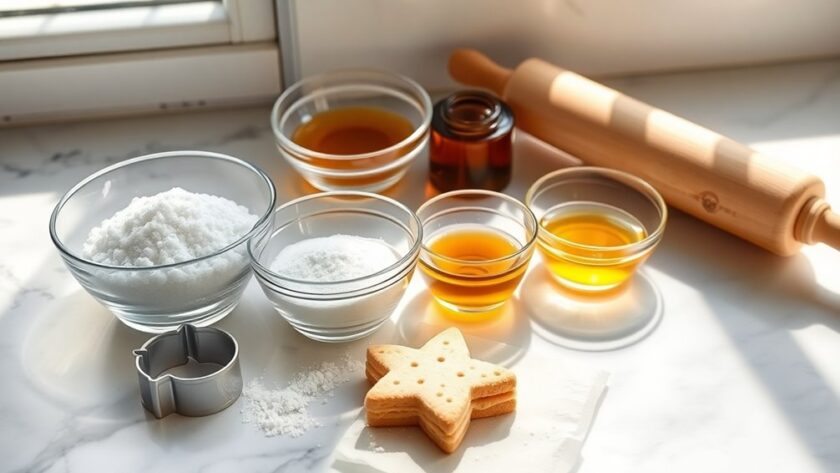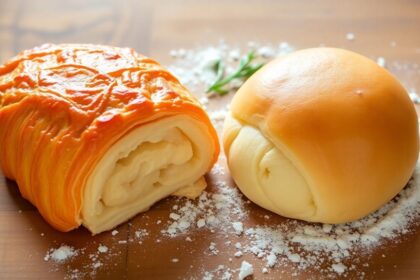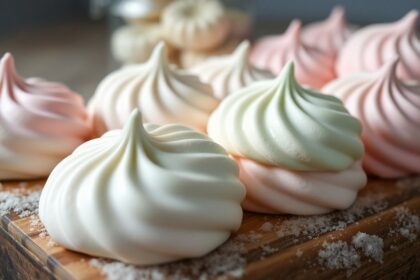Yes, you can make cookies without brown sugar! Just swap it out for granulated sugar, but keep in mind your cookies will be lighter and crispier. To maintain moisture and add a caramel flavor, mix in some molasses. You might also try alternative sweeteners like maple syrup for a unique twist. Each substitute can change the texture and appearance of your cookies. Stick around to discover more tips and tricks for baking delicious cookies without brown sugar!
Understanding the Role of Brown Sugar in Baking
When you bake, the type of sugar you choose can dramatically affect your cookies' final texture and flavor.
Brown sugar, with its molasses content, adds moisture that results in chewier cookies compared to those made with only granulated sugar. This moisture not only enhances the texture but also deepens the caramel flavor, giving your cookies a darker color. Additionally, using gluten-free ingredients can help cater to those with dietary restrictions while still enjoying delicious cookies. Many bakers also prefer using sugar substitutes to create healthier options without sacrificing taste.
If you substitute brown sugar with granulated sugar, you might end up with cookies that are lighter and crispier around the edges, lacking the complex flavor that brown sugar provides.
To mimic brown sugar's moisture and flavor in a pinch, you can add one tablespoon of molasses for every cup of granulated sugar you use. Additionally, considering alternatives like natural sweeteners can enhance the overall nutritional content of your cookies while keeping them delicious.
Why You Can Substitute Brown Sugar
You can easily substitute brown sugar in your cookie recipes without sacrificing too much flavor or texture. While you'll notice a shift in taste and chewiness, there are plenty of alternative sweeteners to explore. Understanding these changes can help you create delicious cookies that meet your preferences. Additionally, the versatility of chocolate chip cookies has led to numerous popular adaptations that can inspire your baking experiments. For instance, using maple syrup can add a unique depth of flavor to your cookies, much like the delightful twist found in maple syrup pecan oatmeal treats. Many athletes opt for high-protein options to supplement their diet, enhancing the nutritional profile of their favorite treats.
Flavor Profile Changes
Although brown sugar adds moisture and a rich caramel flavor to cookies, substituting it with granulated sugar can still yield delicious results.
When you use granulated sugar instead, your cookies will have a lighter color and a different flavor profile, lacking the depth that comes from brown sugar's molasses.
To mimic that caramel flavor, consider adding a tablespoon of molasses per cup of granulated sugar. This addition can help recreate some of the moisture and enhance the taste of your chocolate chip cookies.
Keep in mind that the absence of brown sugar will result in a slightly crisper texture, which some may prefer.
Don't hesitate to experiment with other sugars like coconut or date sugar for unique flavors in your baking.
Texture Variations Explained
Substituting brown sugar in cookie recipes opens up a world of texture variations that can cater to your preferences.
When you use granulated sugar instead, you'll notice your cookies have a lighter color and crispy edges due to the lack of molasses. This results in a more cake-like texture rather than the traditional chewy bite.
To enhance moisture and flavor, consider adding a tablespoon of molasses per cup of granulated sugar. If you prefer a crisper edge, swap baking soda for baking powder, which lets your cookies spread more during baking.
Experimenting with alternatives like coconut or date sugar can also give your treats unique flavors while still achieving a satisfying texture.
Enjoy the delicious possibilities!
Alternative Sweetener Options
When it comes to baking cookies, there are plenty of alternative sweetener options that can effectively replace brown sugar.
You can use granulated sugar in a 1:1 ratio, but expect a drier cookie texture and less depth of flavor. To mimic brown sugar's moisture and caramel flavor, add 1 tablespoon of molasses per cup of granulated sugar.
Coconut sugar provides a similar flavor with less processing and a lower glycemic index. Liquid sweeteners like honey or maple syrup can also work, but you'll need to adjust the recipe's liquid content.
Finally, date sugar adds nutrients and a unique flavor, though it may affect your cookie texture due to its non-dissolving properties.
Granulated Sugar: The Primary Alternative
When you swap granulated sugar for brown sugar in your cookie recipes, you'll notice some key differences in sweetness and texture.
You'll get crisper edges and a lighter color, but you might need to adjust for flavor since granulated sugar lacks that rich, caramel depth. Adding a bit of molasses can help bridge the gap. Additionally, consider using healthier ingredient swaps to enhance the nutritional profile of your cookies. Protein cookies can also be a delicious alternative that provides added nutrients without sacrificing taste. Gluten-free flour can also affect the overall texture of your cookies when using different sugars.
Sweetness Level Comparison
How does granulated sugar stack up against brown sugar regarding sweetness?
Granulated sugar can be used as a 1:1 replacement in cookie recipes, delivering the necessary sweetness without changing the dough's structure. While it produces crispier cookies, brown sugar contributes to a chewier texture.
Because granulated sugar lacks molasses, cookies made with it tend to have a lighter color and milder flavor profile. If you want to mimic the deeper flavor and moisture of brown sugar, add 1 tablespoon of molasses per cup of granulated sugar.
Ultimately, cookies made with granulated sugar are great for those who prefer crispy cookies over chewy ones, maintaining a delightful sweetness that pairs well with various flavors in your favorite cookie recipes.
Texture Differences Explained
Although granulated sugar is a straightforward substitute for brown sugar in cookie recipes, it markedly alters the texture of the final product.
Cookies made with granulated sugar tend to have a lighter color and slightly crispier edges, lacking the moisture that brown sugar provides. This results in a less chewy texture and a more pronounced sweetness, which might require you to adjust the overall sugar content for balance.
While granulated sugar creates a tender, crumblier cookie, you can add a tablespoon of molasses per cup to mimic the moisture and depth of flavor of brown sugar.
Additionally, cookies made without brown sugar often bake faster, so keep a close eye on baking times to guarantee they maintain a soft center.
Flavor Adjustments Needed
Switching to granulated sugar not only changes the texture of your cookies but also calls for flavor adjustments.
While granulated sugar is a direct 1:1 substitute for brown sugar, it lacks moisture and depth, resulting in a crispier edge and lighter color. To improve the flavor, add 1 tablespoon of molasses per cup of granulated sugar; this mimics the moisture and enhances caramel notes.
Since granulated sugar makes cookies sweeter, you might want to reduce the overall sugar content. Expect a softer center and thicker cookies, especially if the dough isn't chilled before baking.
Finally, adjust your baking techniques by monitoring closely to avoid overbaking, as cookies can become hard if left too long in the oven.
Enhancing Flavor With Molasses
If you're looking to enhance the flavor of your cookies without brown sugar, incorporating molasses is a delicious solution. Here's how you can do it effectively:
- Mixing Ratio: Combine 1 tablespoon of molasses per cup of granulated sugar for a similar moisture content and flavor.
- Type Matters: Choose light, dark, or blackstrap molasses based on desired sweetness and richness.
- Chewy Texture: Enjoy a slightly chewier cookie thanks to the moisture content in molasses, which is similar to the texture achieved by using gluten-free flour blends in baking. Natural sweeteners like molasses not only enhance flavor but also contribute additional nutrients to your cookies.
- Added Nutrients: Benefit from extra nutrients like iron and calcium that aren't found in granulated sugar. Additionally, using healthier fats in your cookie recipe can further enhance the overall nutritional profile.
Other Sweeteners to Consider
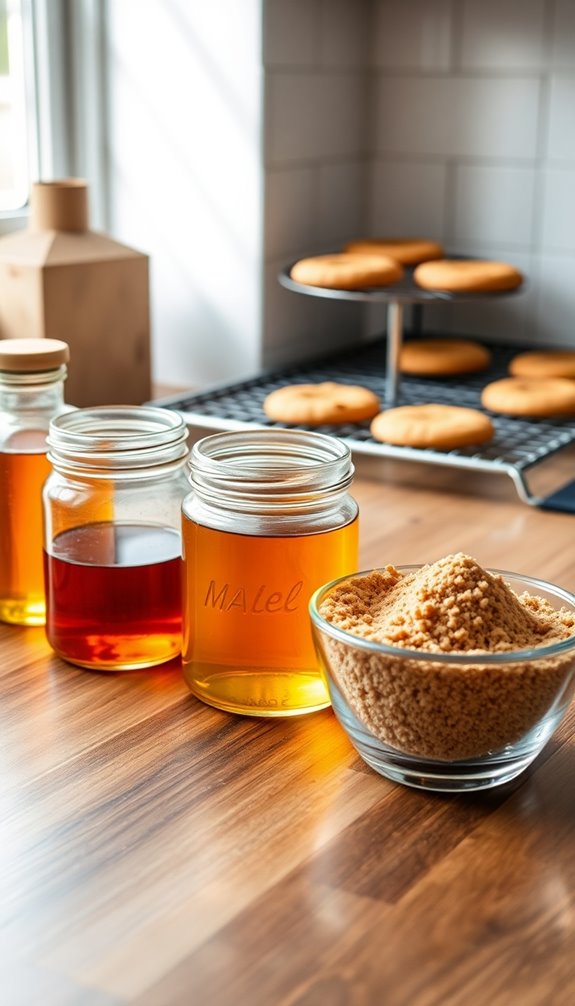
Finding alternatives to brown sugar opens up a world of sweetening possibilities for your cookie recipes. Granulated sugar is a go-to substitute, providing sweetness while resulting in a lighter color and crisper texture. To mimic brown sugar's moisture and flavor, try adding 1 tablespoon of molasses per cup of granulated sugar. Coconut sugar is another great option, offering a lower glycemic index and a flavor reminiscent of brown sugar. Traditional Julekage is an example of a festive treat that uses natural sweetness from dried fruits and spices.
Liquid sweeteners like honey and maple syrup can work too, but remember they may require adjustments in your recipe's liquid content and baking time. Natural sweeteners like honey not only provide sweetness but also add additional nutrients. Ultimately, date sugar delivers natural sweetness and nutrients, though it may affect the texture since it doesn't dissolve like granulated sugar. For gluten-free baking, consider gluten-free flour blends to achieve the perfect cookie texture without compromising on flavor.
Texture and Appearance Without Brown Sugar
While cookies made without brown sugar often have a lighter appearance and crisper edges, you'll notice a significant difference in texture and flavor.
Here's what to expect with cookies without brown sugar:
- Crispy Edges: The absence of brown sugar leads to crispier edges compared to traditional cookies.
- Chewy Texture: You'll find a softer center, creating a chewy texture influenced by granulated sugar instead.
- Simpler Flavor Profile: Without brown sugar's molasses, the flavor profile is more straightforward and sweeter.
- Increased Spreading: These cookies tend to spread more, especially if the dough is warm, affecting their overall appearance.
In short, while they may be light and fluffy, expect differences in moisture and overall texture.
Tips for Baking Cookies Without Brown Sugar
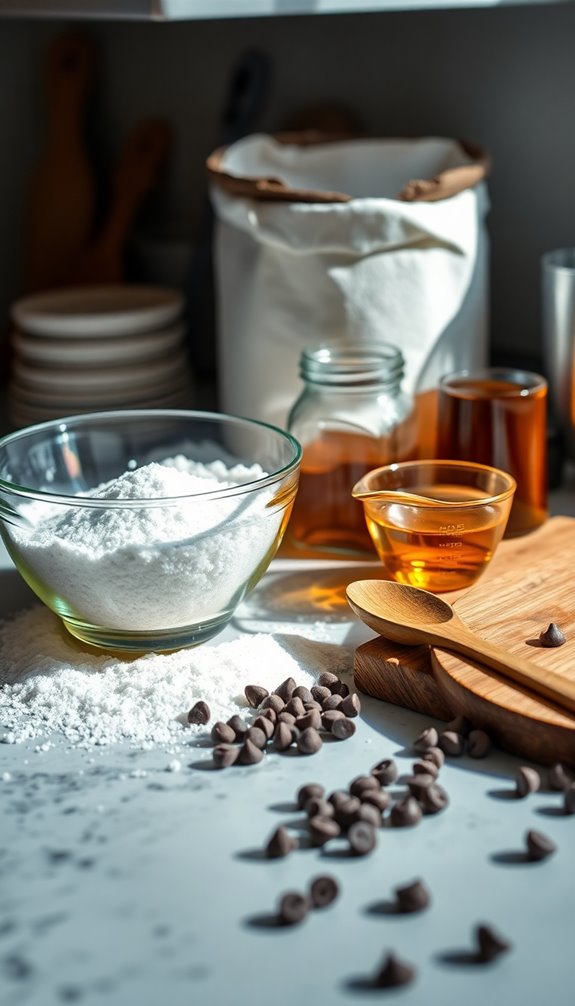
When you're baking cookies without brown sugar, keep in mind that adjusting your ingredients and method can lead to delicious results.
You can substitute granulated sugar for brown sugar at a 1:1 ratio, but for added moisture and flavor, mix in 1 tablespoon of molasses per cup of granulated sugar. This helps mimic the chewy texture you usually get from brown sugar.
To guarantee the best results, weigh your dry ingredients accurately; incorrect flour measurements can yield dry cookies. If you're experimenting with other sweeteners, adjust the dry ingredients accordingly.
Finally, chill the dough for at least 30 minutes before baking to create thicker, puffier chocolate chip cookies that make up for the lack of moisture from brown sugar.
Storage and Freezing Instructions
To keep your cookies fresh and delicious, store them in an airtight container at room temperature for up to 5 days.
For longer storage, you can freeze baked cookies or unbaked cookie dough. Here's how:
- Freeze baked cookies: Place them in a zippered freezer bag for up to 2 months, ensuring they're well-sealed to prevent freezer burn.
- Freeze the dough: Scoop the unbaked cookie dough onto a baking sheet, freeze until solid, then transfer it to a freezer bag.
- Restore gooey texture: Microwave baked cookies for 5-10 seconds before serving.
- Baking from frozen: Allow frozen dough to soften at room temperature, which may require additional baking time of 1-2 minutes.
More Delicious Cookie Recipes
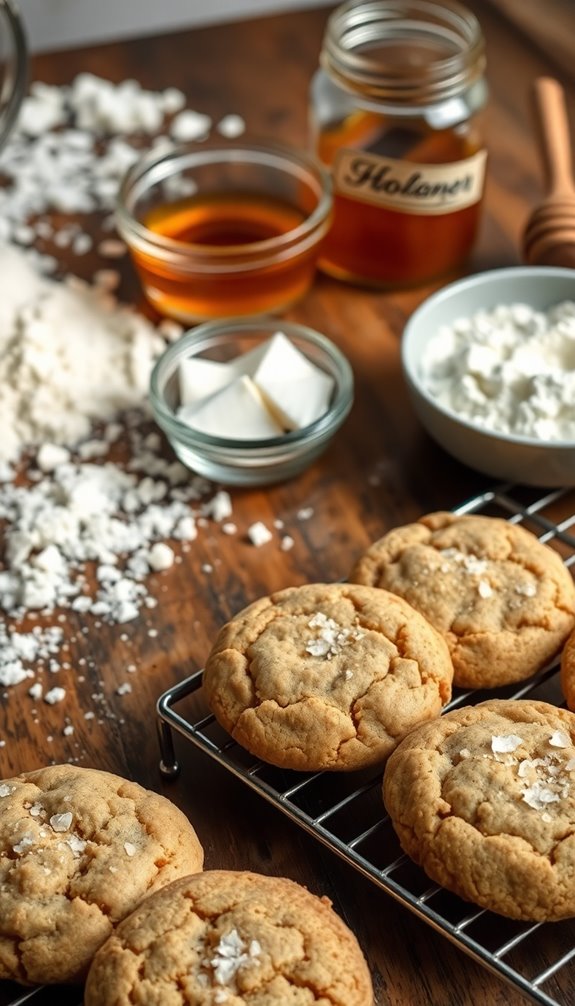
Have you ever wondered how to shake up your cookie game without brown sugar? You can easily create delicious chocolate chip cookie recipes by swapping brown sugar for granulated sugar. This change can give your cookies a different texture and flavor.
Try making almond sugar cookies using almond flour for a nutty flavor and a soft texture. Don't hesitate to experiment with sweeteners like coconut sugar or agave nectar for unique tastes while keeping your cookies soft and chewy.
Incorporate alternative ingredients like nut butters or oats for added nutrition and flavor. For an extra twist, use flavored extracts like almond or peppermint to enhance your homemade cookies.
Get creative and enjoy your chewy chocolate delights!
Conclusion
So, if you're out of brown sugar, don't fret—your cookie dreams aren't dashed. Just remember, like a phoenix rising from the ashes, you can create delicious treats using granulated sugar or other sweeteners. Embrace the journey of experimentation, and you might discover a new favorite recipe. After all, baking is about creativity and joy, not just the ingredients. With a little ingenuity, those cookies will still bring warmth and comfort to your home. Happy baking!

